
|
J A C K E T # 5 |
|
back to Jacket # 5 contents page
back to Jacket's homepage |
| | 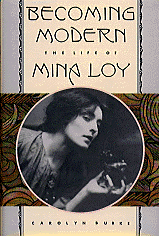
Introduction BECOMING MODERN The Life of Mina Loy University of California Press ISBN 0-520-21089-1 paperback US$18.95 by Carolyn Burke |
|
| | LINK: Interview with Carolyn Burke 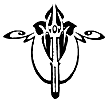 I FIRST HEARD of Mina Loy when I was living in Paris twenty years ago. A fin-de-siècle English painter, she had made her name, quite unexpectedly, as a writer of vers libertine -- the sort of free verse that in the 1910s seemed to lead to free love. To the modernists, she was the first to chart the sensibility of the "new woman." Ezra Pound praised her intellect and her refusal to traffic in sentiment, the staple, he judged, of women poets. (Her poems bristled with such intelligence that Pound coined the term "logopoeia" to describe them.) William Carlos Williams, Hart Crane, and E. E. Cummings all learned from her example. In the 1920s she was as well known as Marianne Moore, the other female modernist with whom she was frequently compared.
I FIRST HEARD of Mina Loy when I was living in Paris twenty years ago. A fin-de-siècle English painter, she had made her name, quite unexpectedly, as a writer of vers libertine -- the sort of free verse that in the 1910s seemed to lead to free love. To the modernists, she was the first to chart the sensibility of the "new woman." Ezra Pound praised her intellect and her refusal to traffic in sentiment, the staple, he judged, of women poets. (Her poems bristled with such intelligence that Pound coined the term "logopoeia" to describe them.) William Carlos Williams, Hart Crane, and E. E. Cummings all learned from her example. In the 1920s she was as well known as Marianne Moore, the other female modernist with whom she was frequently compared.In her many years abroad, Mina Loy also befriended Gertrude Stein, John Reed, Djuna Barnes, James Joyce, Constantin Brancusi, Peggy Guggenheim, Tristan Tzara, Natalie Barney, Ford Madox Ford, Marcel Duchamp, and Man Ray, to name a few of her "crowd." She makes brief, brilliant appearances in expatriate memoirs: one catches sight of her in New York during the Great War, in the hectic avant-garde of postwar Berlin, at the opening of a risqué Paris nightclub or a clandestine Surrealist film showing in the twenties. By the mid-thirties, however, she had disappeared, and her poems were out of print. |
|
| | 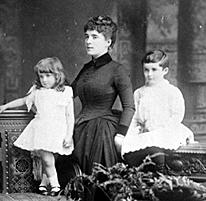
Dora, Julia, and Mina Lowy, London, c. 1886 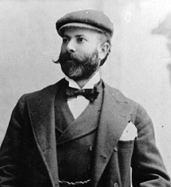 Sigmund Lowy, London | |
| | Mina Loy was forgotten, Kenneth Rexroth thought, because her poems were unlike those of any other woman poet. Indeed, they defied the category. Subordinating the pleasures of lyricism to wit, irony, and a fierce sense of justice, she forced readers to think--whether they liked it or not. Now, when poetry reflects concerns with sexual difference as well as the relations between language and perception, she seems decades ahead of her time. Although Lunar Baedecker [sic], her first book of poems, has been a collector's item since its publication in 1923, the voice that speaks from its pages is decidedly that of a modernist; her poems see art, love, sex, and childbirth from the perspective of a new woman. Yet she had adopted this perspective through an effort of will, just as she had taken her name. |
|
| |  MINA LOY was born Lowy in 1882, a time of overt anti-Semitism in England, to a Christian mother and a Jewish father. She adopted "Loy" for her first painting exhibition in Paris: the name, which suggested French antecedents, hinted that she would be a law (loi) unto herself. But "Loy" was only the first in a series of verbal disguises. Her name changes would mark reformulations of identity. The anagrammatic shifts of Lowy into Loy and later Lloyd symbolize her attempts to resolve personal crises. In this book, she is Mina -- the name that stayed fixed as her surname varied. (Even "Mina" by itself could be volatile; in some moods she announced contrarily that it was pronounced "miner," British style.)*
MINA LOY was born Lowy in 1882, a time of overt anti-Semitism in England, to a Christian mother and a Jewish father. She adopted "Loy" for her first painting exhibition in Paris: the name, which suggested French antecedents, hinted that she would be a law (loi) unto herself. But "Loy" was only the first in a series of verbal disguises. Her name changes would mark reformulations of identity. The anagrammatic shifts of Lowy into Loy and later Lloyd symbolize her attempts to resolve personal crises. In this book, she is Mina -- the name that stayed fixed as her surname varied. (Even "Mina" by itself could be volatile; in some moods she announced contrarily that it was pronounced "miner," British style.)* |
|
| | *It was curious to experience the continual mix-up between Mina Loy and Myrna Loy while I was working on this book. Rexroth, who knew both women, told me that the actress, née Williams, named herself after the poet, but efforts to have this story confirmed went unrewarded. Myrna Loy's account of her name change is nonetheless compatible with Rexroth's. In the 1920s she took "Loy" at the suggestion of a friend, "a wild Russian writer of free verse," who surely knew Mina's reputation. |
|
| | A poet's poet despite the academy's dismissal of her as "minor," a pun she would have enjoyed, Mina was rediscovered and reforgotten for decades. The recent revival of her work owes much to Rexroth, who carried on a one-man campaign to make it available. "There is no question but that she is important and should be reprinted," he argued in 1944. "No one competent and familiar with verse in English in this century would dream of denying it." In the 1960s, when Rexroth's friend Jonathan Williams mentioned his limited edition of her poems to Pound -- by then immured in the silence of his Venetian years -- the old poet opened up and talked for hours of the free-verse wars, the Little Review scandals, and Paris in the twenties. Mina Loy was the key that unlocked his memory. |
|
| | 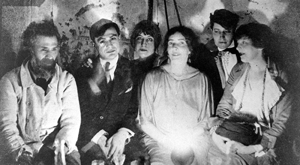 Brancusi's studio, Paris: Constantin Brancusi, Tristan Tzara, unidentified woman, Mina Loy, Jane Heap, Margaret Anderson For us, decades later, her name opens the door to an era of spirited exchanges between American and Continental vanguards. It conjures up smoky art classes in prewar Montparnasse, costume balls at Mabel Dodge's Florentine villa, Futurist soirées where enraged audiences hurl vegetables at the stage, Dadaesque poetry readings, gossipy visits with Gertrude Stein and Alice B. Toklas, dinners in Brancusi's studio among half-finished blocks of marble -- all scenes that reveal the shapes of the modernist imagination. Her life, that of a woman peculiarly responsive to the social and artistic movements of her time, allows us to look more deeply into the self constructing strategies of the international avant-garde.  "Celestial Globe," lamp by Mina Loy, c. 1927 But as her title Lunar Baedecker suggests, Mina Loy also saw herself as a cartographer of the imagination -- at a time when terms like "expatriate" and "exile" held somewhat different meanings than in ours. This biography follows her on voyages of many kinds, tracing her development from a repressive London childhood in the 1880s to art studies in fin-de-siècle Munich and Paris, the Florence of Futurism, and New York in the days of Dada, to revolutionary Mexico (with Arthur Cravan) and postwar Europe (after his disappearance), then back to the United States, where she spent the rest of her life. Her transits describe not linear progress but a series of motions like the epicycles on the celestial maps in which she sought inspiration -- travel as an elliptical form of quest. Leaving England at the turn of the century meant escaping from the repressive forces embodied by her mother: the complacency of British culture, its contradictory goals for daughters, the constraints of London in the 1890s (the time of the Oscar Wilde trial and public condemnation of "immoral" art). In Munich, Paris, Florence, and New York, Mina was able to turn her back on the class system that had put her at a disadvantage. And while she longed to get free of all that England represented, she also yearned to find in the community of "geniuses" an alternative home. |
|
| |  "Stars," ceiling light and wall sconces, by Mina Loy, c. 1927 | |
| | 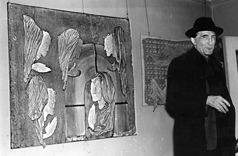 "Bums Praying," assemblage by Mina Loy, with Marcel Duchamp |
|
| | Yet in some ways, despite her residence in these centers of modernism, she remained a late Pre-Raphaelite whose artistic voyages were shaped in reaction to a fin-de-siècle aesthetic. Mina spent much of her life critiquing the values of art-for-art's-sake, eventually finding the means to dethrone assumptions about the superiority of "fine art." Anticipating the Surrealists in her appreciation for the underside of high culture (the flea market castoffs dignified by others as objets trouvés), she gave her lowly discoveries new life in the form of lamps, collages, constructions, and a variety of poetic decors -- all "applied" arts of unusual and fragile beauty. Her travels and her assemblage of art from shards are related: their metaphors of waywardness and fixity, fragmentation and wholeness, hint at her movements toward a state of grace. For her life is also the story of a soul's progress. Mina's "memoirs" are fragmentary and incomplete. Though I had expected more coherence from her autobiographical writings than finally emerged once they were collated, I have nonetheless been guided by her perspective on her development -- from repressed oldest child of a troubled family to timidly rebellious art student to promising artist whose early recognition was eclipsed by marriage and the accidents of so-called private life. Other patterns have also emerged to suggest that her lifelong tendency to blame others, starting with rage at her mother, did not abate. The tenor of this particular prose is so wrathful that its anger still crackles, just as some of her poems all but bite the reader. In the end, Mina did not achieve her goal -- recognition as one of the "geniuses" -- and she came to see this goal as misguided when its achievement set one apart from others. What she did achieve was the considerable goal of seeing her life as expressive of a time and place -- a late-Victorian social milieu seething with the prejudices that distorted relations between the sexes and the possibility of self-affirmation for women. As she understood, hers was a life at the intersection of public and private, one that illuminates the concerns of its era. Mina was, in some ways, her era's poetic consciousness -- as Harriet Monroe (editor of Poetry) called her, its "guide to the moon." I have tried to give the feel of Mina's inwardness by making use of her own metaphors of self-discovery. If maps and Baedekers symbolize the quest that shaped her transits through the modernist landscape, the image of the book expresses her enigmatic spiritual searching. In childhood, when she learned to regard the Bible as the vessel of truth, books became doorways through which to take imaginary voyages. A book was an object inhabited by and inhabiting space. For this reason, no doubt, Lunar Baedecker streamlines the language of Genesis and Revelation. Ideally, its images should be lit from within. |
|
| |  Mina Loy, Paris, c. 1905 "I never was a poet," she declared in the 1950s. (T. S. Eliot said that it was hard to evaluate her because she lacked an "oeuvre," an anachronistic demand for a woman of her time.) She has been neglected because she paid no heed to the requirement for consistent self-presentation in an age that, increasingly, valued professionalism and its external sign, the career. Over the course of her long life, Mina acted, wrote feminist and utopian tracts, explored occult religious and spiritual practices, and made a haphazard study of what turn-of-the-century intellectuals called the New Thought -- including everything from Nietzsche, Bergson, and Freud to Vedanta and Pragmatism. (She also had two husbands, four children, and several complicated love affairs.) We see her as an innovative poet with her roots in art; she saw herself as a painter called to language. Yet her life was more varied than these labels imply, and its variety attests to the abundance of impulses behind modernism. It may be that in her multiplicity, Mina speaks to us now, in the era of the postmodern, because she followed no one path and did not present a unified body of work. | |
| | 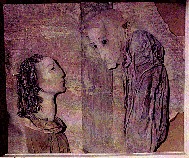 Untitled assemblage by Mina Loy, private collection, Aspen This temperamental stance has made the reconstruction of her life all the more challenging in that biographical narrative relies more on chronology than "assemblage" -- a principle in some ways better suited to Mina Loy, if not the reader. But if biography eschews the strategies of modernist juxtaposition (even though, like this one, it works with fragments), it may nonetheless acknowledge its subject's love of the world's, and the self's, variety. I have come to feel that Mina lived her trajectory, her spiritual zigzags, in full awareness of her contradictions, and that she cherished them all as facets of her "genius." This book relies on Mina Loy's "subconscious archives," the trove of her lightly veiled fiction and autobiography constituting her memoirs. I have approached this rich storehouse with empathy and with caution, aware that the woman who wrote to make sense of her life also did so to justify herself. Moreover, I have become acutely aware of the biographer's tendency to identify with the subject, to whom she is drawn by some mysterious affinity. (Resurrecting another's life may become a calling, as the current owner of Mina's Florence house observed.) Because Mina's memoirs include everything from after-the-fact noting of dialogue to settling of accounts, I have sifted through them with a set of variable meshes, seeking consistency, plausibility, and externally verifiable information. This process came to resemble the psychic activity she called "silting the appraisable" -- letting the weightier elements sift through the mesh of interpretation as the rest volatilizes. 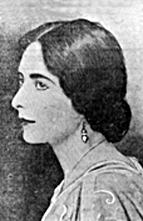 Mina Loy interviewed as the "New Woman," LINK: Interview with Carolyn Burke Ordering Information: Becoming Modern: The Life of Mina Loy, by Carolyn Burke, ISBN 0-374-10964-8 Hardback, Farrar Straus and Giroux, US$35 Published in Canada by Harper Collins, Canada Ltd. CAN$49 ISBN 0-520-21089-1 paperback, University of California Press US$18.95. Available at local bookstores throughout the United States and Canada. Bookstores may order through Ingram or Baker & Taylor, and individuals may use these direct links to order via the Internet: directly from the publisher, the University of California Press in the USA from Amazon books in the UK from The Internet Bookshop in France from the Village Voice Bookshop in Paris and in Australia from Gleebooks in Sydney or Readings in Melbourne Copyright © Carolyn Burke and Jacket magazine 1998 The URL address of this page is http://jacketmagazine.com/05/mina-intro.html |
|
| J A C K E T # 5 Back to Jacket # 5 Contents page Select other issues of the magazine from the | Jacket catalog | Other links: | top | homepage | bookstores | literary links | internet design | Copyright Notice - Please respect the fact that this material is copyright. It is made available here without charge for personal use only. It may not be stored, displayed, published, reproduced, or used for any other purpose | about Jacket | |